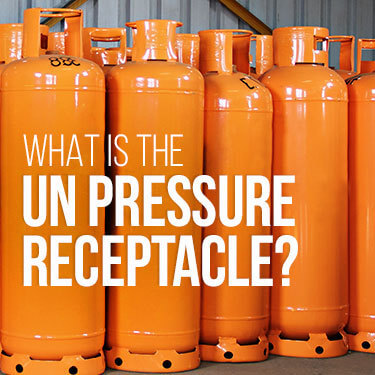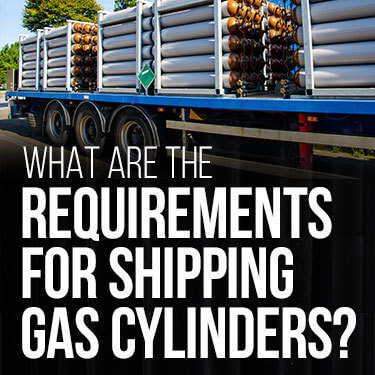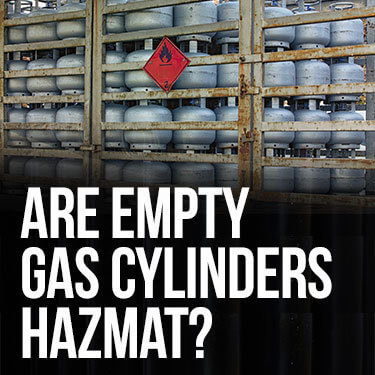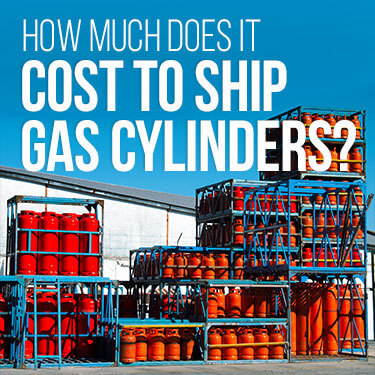Shipping compressed gas cylinders can be a delicate and stressful process. There are a number of regulations shippers need to adhere to and it can be difficult to keep track of each of them.
According to the Department of Transportation (DOT), individuals shipping compressed gas cylinders must comply with Title 49 of the Code of Federal Regulations (CFR). Additionally, compressed gas must be shipped using a hazmat carrier and comply with additional regulations depending on the type of cylinder being shipped.
At R+L Global Logistics we ship freight of all kinds and offer hazmat services. We make sure that all hazmat shipments adhere to DOT regulations as outlined by Title 49 of the CFR so that all your freight gets from Point A to Point B successfully. Read on to learn more about how to ship compressed gas cylinders.

A UN pressure receptacle is the harmonized regulatory name for gas cylinders and is recognized worldwide. The UN pressure receptacle can come in many different sizes and can store different types of gas content within them. The term UN pressure receptacle is important to know because Title 49 of the CFR uses this term to describe compressed gas cylinders often.
There are two types of pressure classifications amongst compressed gas cylinders which are high pressure and low pressure. The high-pressure cylinders are characterized by how tall they are. Cylinders that carry high-pressure gasses are also heavier and their walls are thick.
Low-pressure compressed gas cylinders are much flatter in their appearance. These cylinders also have thinner walls and weigh less than their taller counterparts. Some of the gasses typically carried in each include:
| High-Pressure Cylinder | Low-Pressure Cylinder |
| Nitrogen | Propane |
| Helium | Butane |
| Hydrogen | Isobutane |
| Oxygen | Propylene |
| Carbon Dioxide | Acetylene |
Because gas cylinders can vary in size, their weight can fluctuate greatly. The most common cylinders tend to be around 20 to 100 pounds. Despite these size and weight differences, high-pressure and low-pressure gas cylinders have different dimensions.
Another feature of gas cylinders is that some are refillable while others are not. When a non-refillable cylinder is used up, it must be disposed of properly.
Refillable cylinders on the other hand are given an authorized service life. Once they have expired, they will also have to be disposed of.
Compressed gas cylinders are regularly used pieces of equipment in the welding field. Shipping welding equipment like a compressed gas cylinder requires the utmost care.
There are many different types of gasses that cylinders can carry within them. However, all of them can be divided into three categories. These categories are
The reason there are so many regulations that need to be followed to transport compressed gasses and the cylinders holding them is because of their health hazards they pose. Some cylinders carry flammable gas like hydrogen.
Other gasses could have inhalation hazards due to their toxicity like methyl bromide. Some gasses have corrosive characteristics like chlorine, while others have oxidizing characteristics such as nitrous oxide. Any of these hazards could harm people or even the vehicle transporting the cylinders to their destination.

The most important requirement for transporting compressed gas cylinders is to follow Title 49 of CFR. Within Title 49 of the CFR, part 173.301 outlines the general requirements for the shipment of compressed gas cylinders.
Requirements for compressed gas cylinders are the only ones you will have to worry about. There are also numerous requirements placed on the driver and the vehicle carrying compressed gas cylinders.
In short, Title 49 Part 173.301 of the Code of Federal Regulations provides all of the general requirements for transporting compressed gas cylinders. The summarized list of regulations that have to be followed for a shipment of compressed gas cylinders are:
Title 49 Part 173.301 of the CFR provides vehicle and transportation requirements for transporting compressed gas cylinders. These requirements help maintain the safety of the cylinders and by extension, the vehicle and driver as well.
The first regulation that DOT discusses is in regards to manifolding compressed gas cylinders. Manifolds are devices that are used to supply gas into cylinders. DOT allows manifolded cylinders to be shipped as long as they are kept together.
Cylinder valves are required to have protection when they’re shipped. Valve protection is important because a damaged valve means that gasses can escape from the cylinder. Likewise, a damaged valve could prevent filling the cylinder with gas as well.
On top of these DOT regulations, there are three items that vehicles carrying compressed gas cylinders should always have. The first is shipping papers which provide information about the hazardous materials within the cylinders.
The second item that shipping vehicles need to have when they haul compressed gas cylinders is the North American Emergency Response Guide. In case there is an incident with the shipment of cylinders, the driver will know what to do in order to keep themselves and others safe.
Lastly, vehicles will need a Federal Motor Carrier Safety Administration (FMCSA) license if the vehicle is transporting cylinders with the following contents:
Many of the materials compressed gasses stored inside cylinders are hazardous. This means that drivers are required to have the following certifications to ship compressed gas cylinders.
Drivers that are transporting a quantity of compressed gas over 1,001 pounds will need to have the following criteria:
The last part of Title 49 Part 173.301 that you should be familiar with is DOT’s restrictions on certain cylinders and cylinder attachments. One of these restrictions is on non-specification cylinders.
These are cylinders that are not made to the specifications of either DOT or the UN. Cylinders with a DOT exemption, special permit and cylinders that are used as fire extinguishers under Title 49 Part 173.309 are considered non-specification cylinders as well. All of these types of cylinders are prohibited from being transported.
Cylinders with metal attachments are not permitted to be shipped unless the attachments have rounded corners, chamfered corners or some other type of protection. This will prevent the possibility of the attachments from puncturing the hazardous materials packages.
The last cylinder restriction is on cylinders made of aluminum alloy 6351-T6. Compressed gas cylinders that are made of this material cannot be shipped if they’re filled with pyrophoric gasses. UN pressure receptacles made from this material are prohibited altogether.
For further details about DOT and Hazmat standards be sure to check out our article that takes an in-depth look at DOT hazmat classes.

Empty compressed gas cylinders are still considered hazardous if they were carrying division 2.1 flammable gasses or division 2.3 toxic gasses. For division 2.2 non-flammable and non-toxic gasses, the answer is a little more complex. Cylinders that carried this type of gas are not considered hazmat if they meet the following criteria:
Empty cylinders that carry division 2.2 gas that meet these criteria can be shipped without having to follow hazardous material regulations (HMR) of DOT. When shipping these types of cylinders it’s important that any labels marked on the cylinder that indicates it was a hazmat must be removed.
If you're worried about finding a reliable hazmat shipper to move your cylinders whether they’re full or not then look no further than R+L Global Logistics. On our hazmat carriers page you can learn more about all of our reliable and safe hazmat services.

When making a bulk shipment of five to 10 compressed cylinders you could spend anywhere between $161 and $785. There are many factors that contribute to these shipping prices such as weight, distance and the fact that the cylinders are carrying hazmat material.
Compressed gas cylinders typically weigh around 20lbs to 100lbs so shipping five to 10 compressed gas cylinders will cost around $110 to $540 based on their weight. Next, you have to consider the distance that your shipment will travel.
Shipping zones measure the distance that freight will travel. The higher the shipping zone, the higher the price will be to ship in that zone and the further the distance will be. Lastly, you will have to add in the hazmat fees which are typically around $35 depending on the shipper.
If you need help transporting compressed gas cylinders then R+L Global Logistics is the partner you need. We specialize in hauling bulk shipments of freight of all varieties to their destination. This includes hazmat shipments like compressed gas cylinders.
As logistics experts, we will make sure that your shipment will take the fastest and most efficient route possible. Safety is another important policy at R+L Global Logistics which is important when shipping hazmat goods.
Start the shipping process for shipping compressed gas cylinders by filling out your quote today.
R+L Global Logistics
315 NE 14th St., Ocala, FL 34470